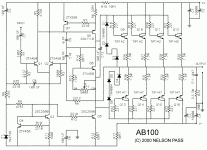Wünderbar!They are, as far as i can see i your screen shots.
Ztx: CBE (center base)
Bc: ECB (center collector)
Yes STV is correct, BUT stop fretting STV you've handled it better than I did. I twisted but didn't insulate and it has been operating well for 5 years. Your insulation is even better, run with it. Stoxx maybe you need to look again.
I was up too late doing puzzles and texting my mother. Sorry, I was all over the place.Stoxx maybe you need to look again.
No harm, no foul! Thanks to STOXX, stv, and Freecrowder for taking the time to respond to my post. The more eyeballs there are viewing any given problem, the better the chance of success, is my viewpoint. I don't think I would be inclined to take on a relatively complex audio project like the AB100, without the existence of this forum.
Quite a few people, including myself with the (4) cap version running at +\-52vDC. Easy to build, lots of transistor substitutions available.
Thank you bullittstang!
What is highest DC rail voltage possible? - for bass amp, assuming appropriate heat radiators with 4 ohms load
What is highest DC rail voltage possible? - for bass amp, assuming appropriate heat radiators with 4 ohms load
Not sure I'm the best for that question - I love building, blowing up and fixing amps (it's my hobby and I'm good at blowing them up), but I would say +/-42Vdc would be the "safe" 4-ohm voltage without exceeding SOA of the outputs. Personally, I have played mine into an easy 3.5r load pair of speakers for hours without the amp seeming to get that hot. Not sure if my heatsinks would be considered minimum, or oversized - they are 10-1/2" long, 3/8" base with 1-1/2" fins and 3-1/8" tall. You don't need much bias for the amp to sound good, either and you could also sub for some beefier Darlington's that might give you a little more SOA at 4-ohms - like I said earlier, the circuit is pretty forgiving of substitutions.
I have repaired Denon and Marantz AVRs that run similar Darlington's close to +/-60Vdc, but I wouldn't say they are 4-ohm stable amplifiers either. They also tend to have a thermal switch with fans, in case of any thermal issues.
I have repaired Denon and Marantz AVRs that run similar Darlington's close to +/-60Vdc, but I wouldn't say they are 4-ohm stable amplifiers either. They also tend to have a thermal switch with fans, in case of any thermal issues.
not necessary to have a jumper, as long as you have C10 in circuit, they are in parallel with each other.
I have built the amp with the NP pcb layout (prasi has also done a layout as well). On the NP pcb the input GND - which is tied to the PSU GND via tracks is at the junction of C8 neg, R2, R8 and C5 neg. Note, there is a mistake on the Pass schematic you post above - the resistor shown as R35 (221R) does not exist - draw a line through that to give that junction to GND. There is also missing the GND symbol at that point on the Pass schematic.
Note, the prasi pcb and schematic shown in this thread is correct and also shows a 10R GBR.
Also note there is an error on the Pass pcb silk screen for transistor Q7 - the transistor outline is reversed as the emitter pin is at the other end compared to resistors Q1 and Q2. So insert Q7 with the flat opposite the silk screen - or 180 deg rotation compared to Q1 and Q2.
Other than that the amp worked perfectly and biased well with very low DC offset and sounds very good for an AB amp.
Note, the prasi pcb and schematic shown in this thread is correct and also shows a 10R GBR.
Also note there is an error on the Pass pcb silk screen for transistor Q7 - the transistor outline is reversed as the emitter pin is at the other end compared to resistors Q1 and Q2. So insert Q7 with the flat opposite the silk screen - or 180 deg rotation compared to Q1 and Q2.
Other than that the amp worked perfectly and biased well with very low DC offset and sounds very good for an AB amp.
Last edited:
- Home
- Amplifiers
- Pass Labs
- AB100 Class AB Power Amplifier
